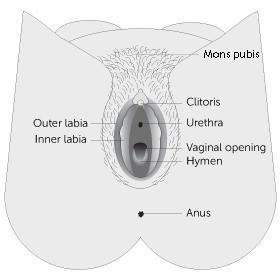What are Tampons and How Do They Work?
Tampons are products used to absorb your menstrual flow. They are made of soft cotton pressed together to form a cylinder-like shape, so that they can be easily inserted into the opening of the vagina. A tampon absorbs your menstrual flow, or blood, before it has a chance to leave the body so they are considered “internal” protection whereas pads are “external” period protection. Tampons come in all different sizes and absorbencies. You can buy them at most pharmacies and grocery stores.
What Size Tampon Should I Use?
It’s a good idea to use the “slender” size tampon when you are learning how to use them for the first time. It’s also easier to insert it when your menstrual flow is moderate to heavy as this allows the tampon to glide in more easily.
I’m Nervous; What Should I Do to Make Inserting the Tampon Easier?

- By following the simple guidelines below, as well as the instructions that come with the tampons, your first experience with tampons should be easy. Remember, the more you relax, the easier the insertion will be. When you are nervous, your muscles tense up, which can make inserting the tampon more difficult.
- Getting Ready: Before you insert the tampon, let’s review your anatomy so you know where to insert it. It’s a good idea to use a mirror to look at your vulva or outside area, which is all of your female genitalia (parts) that you can see. The urethra is where your urine (pee) comes out, the anus is where feces (poop) come out and right in the middle is your vaginal opening. This is where you will insert the tampon into your vagina. It’s normal to feel nervous the first time you use a tampon. It does get easier though.
- Instructions for Inserting a Tampon with a Built-In Applicator:
- Wash your hands with soap and water. With dry hands, unwrap the tampon. If you drop the tampon on the floor, throw it away and begin again with a new tampon.
- Sit or stand in a comfortable position. Some women prefer to place one leg on the toilet seat or tub, while others prefer to squat down. After you find a position that is most comfortable for you, hold the tampon with the fingers that you write with. Hold the middle of the tampon, at the spot where the smaller, inner tube inserts into the larger, outer tube. Make sure the string is visible and pointing away from your body.
- With your other hand, open the labia (the folds of skin around the vaginal opening) and position the tampon in the vaginal opening. (See picture 1)
- Gently push the tampon into the opening, aiming for the small of your back. Stop when your fingers touch your body and the applicator, or outer tube, is completely inside the vagina. (See picture 2)
- Once the applicator or outer tube is inside your vagina, use your index or “pointer” finger to push the inner tube (the tube where the removal string is visible) through the outer tube. This pushes the tampon into the vagina.
- Once the inner tube is all the way in, use your thumb and middle finger to remove the applicator or outer tube. (See picture 3) Make sure that the string hangs outside of your vaginal opening. Later, when you are ready to remove the tampon, hold the string and gently pull it downward until the entire tampon is out.
- Remember to wash your hands before and after you insert and remove a tampon.
- Instructions on How to Insert a Non-Applicator Tampon:
- Wash your hands with soap and water. With dry hands, unwrap the tampon. If you drop the tampon on the floor, throw it away and begin again with a new tampon. The tampon should be completely sealed in plastic wrap. If not, select another tampon and unwrap it with clean hands.
- Read the directions on the tampon box.
- With clean hands, unwrap a tampon and tug on the string to make sure the string is firmly attached to the tampon.
- Sit or stand in a comfortable position. Some women prefer to place one leg on the toilet seat or tub, while others prefer to squat down. After you find a position that is most comfortable for you, hold the end of the tampon, at the spot where the tampon dents in. Make sure the string is visible and pointing away from your body.
- With your other hand, open the labia (the folds of skin around the vaginal opening) and position the tampon in the vaginal opening. (See picture 1.)
- Gently push the tampon into the opening, aiming for the small of your back.
- Once the tampon is inside of your vagina, use your index or “pointer” finger to push the tampon in.
- Make sure that the string hangs outside of your vaginal opening. Later, when you are ready to remove the tampon, hold the string and gently pull it downward until the entire tampon is out.
- Remember to wash your hands before inserting a tampon and again after you take one out.
- If the tampon is inserted correctly, you should not feel it. If you feel uncomfortable in any way, you may have inserted the tampon incorrectly or the tampon may not be placed far enough into your vagina. If this happens, just remove the tampon and start again with a new tampon. Remember that practice makes perfect. If you don’t get it on the first try, your second try will most likely be successful. Instead of getting frustrated and giving up, relax and try again!
What if I Still Don’t Succeed?
If you’re not able to insert a tampon after several tries, make an appointment with your health care provider. One reason for this is that you may have been born with a very small opening in your hymen, which prevents you from inserting tampons. This is true in only about 2% of teens, but it could be a problem. A mirror is often helpful when you’re trying to insert a tampon for the first time, so that you can see exactly where your vaginal opening is. You can also try using a small amount of vaginal lubricant (K-Y Jelly) on the end of the tampon to help it glide in.
What is TSS?
- TSS stands for Toxic Shock Syndrome. It’s rare but a dangerous infection if you get it. It can occur in girls who wear tampons. Tampons themselves do not cause TSS. TSS is caused by bacteria, usually called Staphylococcus aureus. When a tampon is in your vagina, it creates a perfect environment for different types of bacteria, including Staphylococcus aureus, to grow. The bacteria make a toxin that causes severe illness. Younger teens are less likely to have antibodies against the toxin made by these bacteria. You will probably never get TSS, but it’s good to know what the symptoms are and how to lessen your risk.
- To Lessen Your Risk of Developing TSS, Follow These Tips When Using Them:
- Use care in inserting tampons. Wash your hands before inserting or removing your tampon. (Make sure your fingernails are not sharp or jagged to avoid tearing your skin).
- Change your tampons at least every 4-6 hours or more often if necessary.
- Choose the correct tampon absorbency. Use smaller sized tampons when your flow is lighter. TSS is very rare but more likely with super-absorbent tampons only when you have a heavy flow.
- Alternate between pad and tampon use. Try using pads at night, and tampons in the daytime.
- Don’t use tampons to absorb anything other than your menstrual flow. Only insert a tampon once menstrual blood is present.
- To Lessen Your Risk of Developing TSS, Follow These Tips When Using Them:
- Symptoms of TSS-Toxic Shock Syndrome Usually Come on Quickly, and May Include:
- Flu-like symptoms (muscle aches, headache, redness of your eyes, mouth, and throat)
- Sudden high fever
- Dizziness, fainting, or lightheadedness
- Vomiting
- A sunburn-like rash
- Diarrhea


















